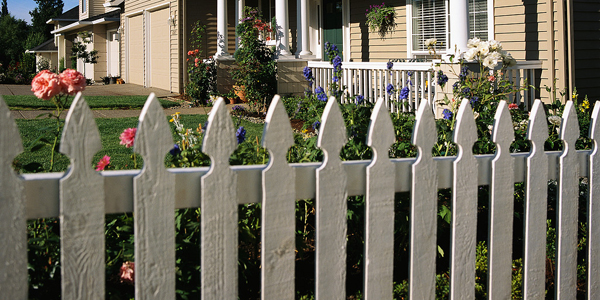
“My apple trees will never get across
And eat the cones under his pines, I tell him.
He only says, ‘Good fences make good neighbors.’”
Mending Wall, by Robert Frost
Many believe that good fences make good neighbors, and there may be some truth to it. A fence keeps your dog, your children, and your party goers in your own yard. It provides a clear dividing line and some privacy. It can also provide some security as well. What Robert Frost doesn’t mention is that an attractive, well-maintained fence can improve curb appeal and your home’s value, too. There are many reasons to build a good fence.
Here are some FAQs about building fences in Central Ohio.
Q: I’ve heard about Ohio Fence Law, does that apply to me?
A: If you are building a fence in a municipal area, where the property is divided into lots and subdivisions, then rural fence law does not apply. If you build in an area where livestock is common, and the lots are measured in multiple acres, check with your local county commissioners or city office, rural fence law may apply to you.
Q: Do I need a building permit?
A: Check your local regulations, but here are a few examples:
- Columbus: Any fence under 6 feet tall does not need a permit, BUT there are strict zoning regulations about corner lots, and visibility from the street. It is crucial to have your fence plan checked if you have a corner lot, or if your plan is for fencing your front yard. Call 614-645-8637.
- Dublin: Yes, you need a permit, and there are regulations about the types of fencing allowed, including a 4′ limit. For more information regarding Dublin’s fencing regulations, contact Land Use and Long Range Planning at 614-410-4600.
- Westerville: Anyone who wants to erect a fence must first obtain permission from the Department of Planning and Development. This can be done by calling 901-6660 or bringing in a plot plan to the Planning & Development Department, 64 E. Walnut Street. While this may seem like an unnecessary step, height, placement and some subdivision deed restrictions make it necessary.
- Worthington: A permit application can be downloaded from the city’s web site.
- Hilliard: Asks you call for information regarding a permit.
- Upper Arlington: The city has good neighbor guidelines, but the city codes must also be enforced.
Q: Do I have to have my neighbor’s permission to erect a fence?
A: Sometimes. In some neighborhoods there are various deed restrictions requiring a neighbor’s permission or requiring a certain kind of fence. In others, there is no such restriction. A wise neighbor talks to the surrounding neighbors before erecting a fence whether required or not. It’s just the nice thing to do. You never know when your next door neighbor is thinking of building a fence, too. You could share the cost and maintenance!
Q: What kind of fence material is the best?
A: First, know what’s legal and accepted in your town or neighborhood. For instance, Dublin forbids pvc fencing of all kinds, and most areas forbid barbed wire. Each material has their own pros and cons. Wood is the most popular, and a reasonable cost, but needs to be stained or painted and maintenance. Metal fencing is durable, doesn’t need a lot of maintenance, but is expensive, and expensive to repair. It also offers less privacy. Vinyl fencing is less expensive, doesn’t need to be painted, but can yellow over time, and can warp in the heat of summer. Wire or mesh fencing with stakes or posts is the least expensive, but many neighborhoods have regulations against it, and it does need some maintenance. It also offers less security and privacy than wood or vinyl. Your fencing contractor can help you choose the right fence for your neighborhood, city, and site. Most offer free estimates on site or online.
Q: Can I attach my fence to my neighbor’s fence?
A: In most areas you can, but you should always talk to your neighbor and your zoning office first. In some areas, if you attach or abut your fence to your neighbor’s, he can ask you to pay for a portion of the joint fence line. If the neighbor objects, consult your zoning office, you may be able to simply sink a fencepost of your own a few inches from the neighbor’s fence and still use the adjoining fence without touching it. In other cases, you can’t, so it’s worth asking both the neighbor and the zoning office!
Q: I’ve heard I have to have my fence facing out, is that true?
A: In Columbus, it’s up to the fence owner. In other areas, like Dublin and Upper Arlington, you must have the “pretty” side facing out, and the support structures facing in. One way to deal with this restriction is to sandwich the support structures between two “pretty” sides. It does add cost, but your fence will look nice from any direction. Or ask your fencing contractor about fences that are equally attractive from both sides. They’ll have a variety to choose from.
Q: What if I choose to put in a living fence, like shrubs or arbor vitae? Do I need permits? Are there restrictions?
A: Yes. Even the rural fence laws provide for living fences and have rules about them. Check with your local zoning office for details. Also, consider your HOA, site, and the upkeep of live plant material. Visibility laws also apply, so you may end up trimming and limiting your live fence several times a year.
Q: Once I put in a fence, am I required to paint or stain it? Are there maintenance laws?
A: It depends on your neighborhood or city. Most places don’t require paint or stain, but they do require the fence to be in safe condition, and weeds to be under control.
Q: I’m planning a fence, but there’s a utility easement in our backyard, what should we do?
A: Check your zoning office before doing anything, and definitely call to have utilities marked before you or your contractor digs, the number is 1-800-362-2764. If your fence is the first to go up, talk to your contractor and zoning office about excluding the easement from your fence line. It may make your yard appear smaller, but you won’t have to be responsible for access to utility poles, boxes, and lines. If yours is the last fence to go up, and the boxes or poles are essentially only accessible from your yard, be aware that the utility companies know this, and will expect to continue accessing their equipment through your yard. You can plan ahead by having a double gate on one side of the house, and asking your contractor to make a portion of your fencing near poles or boxes to be easily removable. That may save you considerable time and money later on!




